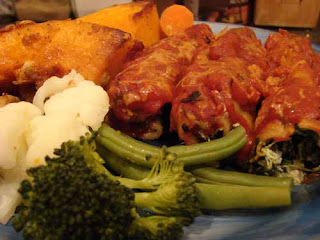Tonight we watched the last episode of TV3's
What's Really In Our Food?, hosted by Petra Bagust. I'll admit I probably only saw about half of this series, because it was one of those rare instances where we were obliged to watch a show at its
actual scheduled time, which is something we are totally not in the habit of doing. But each episode was much the same, so if you saw the ads during the week you'd have a pretty good idea of what it was going to be about. The show covered such things as organics vs big agribusiness, imported vs local, free range vs battery, etc. It tackled chicken, fish, fast food, coffee, packaging, and imported food, among other things. It had the potential to be a hard-edged exploration of the dark side of our mass food market, but instead it proved to, ahem, lack teeth.


The producers of
WRIOF seem to have taken the line that its better not to offend anyone, even at the expense of its viewers' health and wellbeing. It touts itself as an informative piece of journalism, but comes across as a vaguely directionless magazine item, which will suggest the hidden dangers of our food industry but refuses to really expose them. For all her disarming charm, Petra just isn't the hardnosed investigator that this show needed at the helm. Maybe next series the producers will see sense, and hire Jeremy Wells instead. Then we'll get to the bottom of it.
But with due consideration, I can fathom why the producers chose the sharp-as-cotton-wool approach that they did. For a start, no-one wants a lawsuit flying at them that would see their hard work pulled from prime-time TV and all that money going down the gurgler. And when the lawsuits will be coming from the big nasty corporate world who have the most to hide and the most money to spend on lawyers, not many private producers will put their plums on the line for the sake of a half-hour TV slot.
The show in the end took care not to oversensationalise any particular issue, handing the viewer a balanced argument which always erred on the side of safety, with Petra's final disclaimer that she will be reading the fine print and washing all her veges just to be sure.
But here's what I liked about it. OK, there was nothing new to be found in this show, but it did surprise me how little a lot of people out there actually know about what they put in their bodies. (Garlic was a target in tonight's episode, saying much what I said
here. The key thing to note about garlic is that if the roots have been cut off, it's almost definitely imported.) While they refused to openly confront the weak-willed blather spurted by the
FSA, they did something even more subtle. They abandoned the hammer and nails grunt of investigative journalism and replaced it with
the power of suggestion.
In every episode, just after the dangers of whatever they're covering have been carefully downplayed, we see Petra at her laptop smiling and suggesting to the viewer that if they were to go online and search for XYZ, they would find a lot of information about XYZ. Twaddle, you say, how can a self-respecting television show call itself a source of right and proper information if it hands the research off to its viewers? Well, in the grand tradition of
good journalism, the producers have decided that as
consumers, it is up to the public to consider the evidence and make up thier own minds. Give people a framework to start from, and let the public inform itself. Certainly, such an approach actually has some validity in this age of wide-spread internet access. And if even a few people ask a few questions and start delving deeper into the myths and realities that Petra and her pals have raised in this short series, then I'd say that they've done what they set out to do.
My rating: 6.5/10


















































